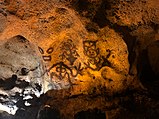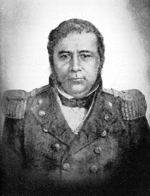
A | B | C | D | E | F | G | H | CH | I | J | K | L | M | N | O | P | Q | R | S | T | U | V | W | X | Y | Z | 0 | 1 | 2 | 3 | 4 | 5 | 6 | 7 | 8 | 9
This article may be too long to read and navigate comfortably. When this tag was added, its readable prose size was 16,000 words. (June 2023) |
Dominican Republic | |
|---|---|
| Motto: "Dios, Patria, Libertad" (Spanish) "God, Homeland, Freedom" | |
| Anthem: ¡Quisqueyanos Valientes! Valiant Quisqueyans! | |
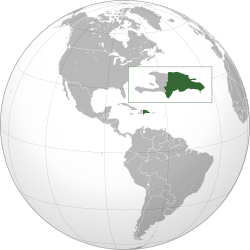 | |
| Capital and largest city | Santo Domingo 19°00′N 70°40′W / 19.000°N 70.667°W |
| Official languages | Spanish |
| Other spoken languages | See below |
| Ethnic groups (2021)[1] | |
| Religion (2018)[2] |
|
| Demonym(s) | Dominican Quisqueyan (colloquial)[3] |
| Government | Unitary presidential republic[4] |
| Luis Abinader | |
| Raquel Peña de Antuña | |
| Legislature | Congress |
| Senate | |
| Chamber of Deputies | |
| Formation | |
| 1821–1822 | |
| 1844–1861[5] | |
| 1865–1916[6] | |
| 1924–1965[7][8] | |
• Fourth Republic | 1966–present[9] |
| Area | |
• Total | 48,671 km2 (18,792 sq mi) (128th) |
• Water (%) | 0.7[4] |
| Population | |
• 2024 estimate | |
• Density | 220/km2 (569.8/sq mi) (65th) |
| GDP (PPP) | 2024 estimate |
• Total | |
• Per capita | |
| GDP (nominal) | 2024 estimate |
• Total | |
• Per capita | |
| Gini (2022) | medium |
| HDI (2022) | high (82nd) |
| Currency | Dominican peso[14] (DOP) |
| Time zone | UTC – 4:00[4] (Atlantic Standard Time) |
| Driving side | right |
| Calling code | +1-809, +1-829, +1-849 |
| ISO 3166 code | DO |
| Internet TLD | .do[4] |
The Dominican Republic[a] is a country on the island of Hispaniola in the Greater Antilles archipelago of the Caribbean Sea, bordered by the Atlantic Ocean to the north. Geographically, the Dominican Republic is part of the North American continent.[15] It occupies the eastern five-eighths of the island, which it shares with Haiti,[16][17] making Hispaniola one of only two Caribbean islands, along with Saint Martin, that is shared by two sovereign states. It is the second-largest nation in the Antilles by area (after Cuba) at 48,671 square kilometers (18,792 sq mi), and second-largest by population, with approximately 11.4 million people in 2024, of whom approximately 3.6 million live in the metropolitan area of Santo Domingo, the capital city.[4][18][19]
The native Taíno people had inhabited Hispaniola before the arrival of Europeans, dividing it into five chiefdoms.[4] Christopher Columbus explored and claimed the island for Castile, landing there on his first voyage in 1492.[4] The colony of Santo Domingo became the site of the first permanent European settlement in the Americas. In 1697, Spain recognized French dominion over the western third of the island, which became the independent state of Haiti in 1804.[4] A group of Dominicans deposed the Spanish governor and declared independence from Spain in November 1821,[4] but were annexed by Haiti in February 1822. Independence came 22 years later in 1844,[4] after victory in the Dominican War of Independence. Over the next 72 years, the Dominican Republic experienced several civil wars, failed invasions by Haiti, and a brief return to Spanish colonial status, before permanently ousting the Spanish during the Dominican War of Restoration of 1863–1865.[20][21][22] From 1930 the dictatorship of Rafael Leónidas Trujillo ruled until his assassination in 1961.[4] Juan Bosch was elected president in 1962 but was deposed in a military coup in 1963. A civil war in 1965 was followed by the authoritarian rule of Joaquín Balaguer (1966–1978 and 1986–1996). Since 1978, the Dominican Republic has moved toward representative democracy.[23]
The Dominican Republic has the largest economy (according to the U.S. State Department and the World Bank) in the Caribbean region and is the seventh-largest economy in Latin America.[24][25] Over the last 25 years, the Dominican Republic has had the fastest-growing economy in the Western Hemisphere – with an average real GDP growth rate of 5.3% between 1992 and 2018.[26] GDP growth in 2014 and 2015 reached 7.3 and 7.0%, respectively, the highest in the Western Hemisphere.[26] Recent growth has been driven by construction, manufacturing, tourism, and mining. The country is the site of the third largest (in terms of production) gold mine in the world, the Pueblo Viejo mine.[27][28]
The Dominican Republic is the most visited destination in the Caribbean.[29] The year-round golf courses and resorts are major attractions.[30] A geographically diverse nation, the Dominican Republic is home to both the Caribbean's tallest mountain peak, Pico Duarte, and the Caribbean's largest lake and lowest point, Lake Enriquillo.[31] The island has an average temperature of 26 °C (78.8 °F) and great climatic and biological diversity.[30] The country is also the site of the first cathedral, castle, monastery, and fortress built in the Americas, located in Santo Domingo's Colonial Zone, a World Heritage Site.[32][33]
Etymology
The name Dominican originates from Saint Dominic,[34] the patron saint of astronomers, and founder of the Dominican Order.
The Dominican Order established a house of high studies on the colony of Santo Domingo that is now known as the Universidad Autónoma de Santo Domingo, the first University in the New World. They dedicated themselves to the education of the inhabitants of the island, and to the protection of the native Taíno people who were subjected to slavery.[35]
For most of its history, up until independence, the colony was known simply as Santo Domingo[36] – the name of its present capital and patron saint, Saint Dominic – and continued to be commonly known as such in English until the early 20th century.[37] The residents were called "Dominicans" (Dominicanos), the adjectival form of "Domingo", and as such, the revolutionaries named their newly independent country the "Dominican Republic" (la República Dominicana).
In the national anthem of the Dominican Republic (himno nacional de la República Dominicana), the term "Dominicans" does not appear. The author of its lyrics, Emilio Prud'Homme, consistently uses the poetic term "Quisqueyans" (Quisqueyanos). The word "Quisqueya" derives from the Taíno language, and means "mother of the lands" (madre de las tierras). It is often used in songs as another name for the country. The name of the country in English is often shortened to "the D.R." (la R.D.), but this is rare in Spanish.[38]
History
This section may contain an excessive amount of intricate detail that may interest only a particular audience. (June 2024) |
Pre-Columbian era

The islands of the Caribbean were first settled around 6,000 years ago by hunter-gatherer peoples originating from Central America or northern South America. The Arawakan-speaking ancestors of the Taíno moved into the Caribbean from South America during the 1st millennium BC, reaching Hispaniola by around 600 AD.[39] These Arawakan peoples engaged in farming, fishing,[40] hunting and gathering,[41] and the widespread production of ceramic goods.[39] The estimates of Hispaniola's population in 1492 vary widely, including tens of thousands,[42] 100,000,[43] 300,000,[41] and 400,000-2,000,000.[44] Estimating how many people lived on the island in pre-Columbian times is challenging, as no accurate records exist.[45] By 1492, the island was divided into five Taíno chiefdoms.[46][47] The Taíno name for the entire island was either Ayiti or Quisqueya.[48][better source needed]
European colonization
Christopher Columbus arrived on the island on December 5, 1492, during the first of his four voyages to the Americas. He claimed the land for Spain and named it La Española, due to its diverse climate and terrain, which reminded him of the Spanish landscape.[49] Initially, after friendly relationships, the Taínos resisted the conquest, led by female Chief Anacaona of Xaragua and her ex-husband Chief Caonabo of Maguana, as well as Chiefs Guacanagaríx, Guamá, Hatuey, and Enriquillo. The latter's successes gained his people an autonomous enclave on the island. Within a few years after 1492, the population of Taínos had declined drastically, due to smallpox,[50] measles, and other diseases that arrived with the Europeans.[51] In 1493, fighting broke out between the Spanish and the Taíno, resulting in the deaths of 39 Spaniards and the destruction of their fort, La Navidad. In 1496, Bartholomew Columbus, Christopher's brother, built the city of Santo Domingo, Western Europe's first permanent settlement in the "New World". The Spaniards created a plantation economy on the island.[43]
The last record of pure Taínos in the country was from 1864. Still, Taíno biological heritage survived, due to intermixing. Census records from 1514 reveal that 40% of Spanish men in Santo Domingo were married to Taíno women,[52] and some present-day Dominicans have Taíno ancestry.[53][54] Remnants of the Taíno culture include their cave paintings,[55] such as the Pomier Caves, as well as pottery designs still used in the artisan village of Higüerito, Moca.[56]
After the near-total destruction of the Taíno population, successful resistance took place between 1519 and 1534. Seeking refuge in the Bahoruco mountains, the Taínos raided Spanish plantations, defeated patrols, and negotiated the first truce between an Amerindian chief and a European monarch. The Taínos were pardoned and granted their own town and charter. African slaves were imported to replace the dwindling Taínos.

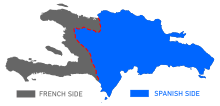
By the time of the Treaty of Ryswick in 1697, which ceded the western one-third of the island to France, the population of Santo Domingo consisted of a few thousand whites, approximately 30,000 black slaves, and a few Taínos on the brink of extinction. [57] By 1789, the population had grown to 125,000, but Santo Domingo remained one of Spain's less wealthy and strategically important colonies in the New World.[57] The population composition of Santo Domingo sharply contrasted with that of the neighboring French colony of Saint-Domingue—the wealthiest colony in the Caribbean and whose population of half a million was 90% enslaved and four times as numerous as Santo Domingo.[58][59]
In 1795, Spain ceded Santo Domingo to France by the Treaty of Basel as a result of its defeat in the War of the Pyrenees. Saint-Domingue achieved independence as Haiti from France on January 1, 1804, after a successful slave revolt that began in 1791. In 1809, the French were expelled from the island and Santo Domingo returned to Spanish rule.[60] This marked the end of 200 years of French presence in Hispaniola.
Ephemeral independence
After a dozen years of discontent and failed independence plots by various opposing groups, including a failed 1812 revolt led by Dominican conspirators José Leocadio, Pedro de Seda, and Pedro Henríquez, Santo Domingo's former Lieutenant-Governor (top administrator), José Núñez de Cáceres, declared the colony's independence from the Spanish crown as Spanish Haiti, on November 30, 1821. This period is also known as the Ephemeral independence.[61]
Haitian occupation of Santo Domingo (1822–1844)

The newly independent republic ended a mere two months later, when it was occupied and annexed by Haiti, then under the leadership of Jean-Pierre Boyer.[62] As Toussaint Louverture had done two decades earlier, the Haitians abolished slavery. Boyer attempts to redistribute land conflicted with the system of communal land tenure (terrenos comuneros), which had arisen with the ranching economy, and some people resented being forced to grow cash crops under Boyer and Joseph Balthazar Inginac's Code Rural.[b] In the rural and rugged mountainous areas, the Haitian administration was usually too inefficient to enforce its own laws. It was in the city of Santo Domingo that the effects of the occupation were most acutely felt, and it was there that the movement for independence originated.
Haiti's constitution forbade white elites from owning land, and Dominican major landowning families were forcibly deprived of their properties. Many emigrated to Cuba, Puerto Rico, or Gran Colombia, usually with the encouragement of Haitian officials who acquired their lands. The Haitians associated the Roman Catholic Church with the French slave-masters who had exploited them before independence and confiscated all church property, deported all foreign clergy, and severed the ties of the remaining clergy to the Vatican. All levels of education collapsed; the university was shut down, as it was starved both of resources and students, with young Dominican men from 16 to 25 years old being drafted into the Haitian army. Boyer's occupation troops, who were largely Dominicans, were unpaid and had to "forage and sack" from Dominican civilians. Haiti imposed heavy taxes on the Dominican people.[63][page needed]
First Republic (1844–1861)

In 1838, Juan Pablo Duarte founded a secret society called La Trinitaria, which sought the complete independence of Santo Domingo without any foreign intervention.[64]: p147–149 Also Francisco del Rosario Sánchez and Ramon Matias Mella, despite not being among the founding members of La Trinitaria, were decisive in the fight for independence. Duarte, Mella, and Sánchez are considered the three Founding Fathers of the Dominican Republic.[65]
On February 27, 1844, the members of La Trinitaria, now led by Tomás Bobadilla, declared independence from Haiti. The Trinitarios were backed by Pedro Santana, a wealthy cattle rancher from El Seibo, who became general of the army of the nascent republic. The decades that followed were filled with tyranny, factionalism, economic difficulties, rapid changes of government, and exile for political opponents. Archrivals Santana and Buenaventura Báez held power most of the time, both ruling arbitrarily. They promoted competing plans to annex the new nation to a major power. The Dominican Republic's first constitution was adopted on November 6, 1844. The state was commonly known as Santo Domingo in English until the early 20th century.[66] The population of the Dominican Republic in 1845 was approximately 230,000 people (100,000 whites; 40,000 blacks; and 90,000 mulattoes).[67]
In March 1844, Haiti invaded, but the Dominicans put up stiff opposition and inflicted heavy casualties on the Haitians.[68] By April 15, Dominican forces had defeated the Haitian forces on both land and sea.[69] In early July 1844, Duarte was urged by his followers to take the title of President of the Republic. Duarte agreed, but only if free elections were arranged. However, Santana's forces took Santo Domingo on July 12, and they declared Santana ruler of the Dominican Republic. Santana then put Mella, Duarte, and Sánchez in jail. On February 27, 1845, Santana executed María Trinidad Sánchez, heroine of La Trinitaria, and others for conspiracy.
In August 1845, Haiti made another attempt to conquer the Dominican Republic, but the Haitian forces were defeated after a short war. After defeating a new Haitian invasion in April 1849 at the Battle of Las Carreras, Santana marched on Santo Domingo and deposed president Manuel Jimenes (who had ousted Santana as president) in a coup d'état. At his behest, Congress elected Buenaventura Báez as president, but Báez was unwilling to serve as Santana's puppet, challenging his role as the country's acknowledged military leader. In November–December 1849, Dominican seamen raided the Haitian coasts, plundered seaside villages, as far as Dame Marie, and butchered crews of captured enemy ships.[70][71] A fourth and final invasion by Haiti in 1855 was defeated, resulting in thousands dead.[72]
In 1853, Santana was elected president for his second term, forcing Báez into exile. Three years later, he negotiated a treaty leasing a portion of Samaná Peninsula to a U.S. company[73] known as the Samana Bay Company of Santo Domingo;[74] popular opposition forced him to abdicate, enabling Báez to return and seize power. With the treasury depleted, Báez printed eighteen million uninsured pesos, purchasing the 1857 tobacco crop with this currency and exporting it for hard cash at immense profit to himself and his followers. Cibao tobacco planters, who were ruined when hyperinflation ensued, revolted and formed a new government headed by José Desiderio Valverde and headquartered in Santiago de los Caballeros. In July 1857, General Juan Luis Franco Bidó besieged Santo Domingo. The Cibao-based government declared an amnesty to exiles and Santana returned and managed to replace Franco Bidó in September 1857. After a year of civil war, Santana captured Santo Domingo in June 1858, overthrew both Báez and Valverde and installed himself as president.[73]
Restoration republic

In 1861, after imprisoning, silencing, exiling, and executing many of his opponents and due to political and economic reasons, Santana asked Queen Isabella II of Spain to retake control of the Dominican Republic, after a period of only 17 years of independence. Spain, which had not come to terms with the loss of its American colonies 40 years earlier, accepted his proposal and made the country a colony again.[75] The island was occupied by 30,000 Spanish troops supported by twenty-two warships. These forces were bolstered by battalions of Cuban and Puerto Rican volunteers. Moreover, 12,000 Dominicans, mainly from the provinces of Azua, Santo Domingo, El Seibo, and the town of Baní, aligned themselves with the Spanish forces.[76] Haiti, fearful of the reestablishment of Spain as colonial power, gave refuge and logistics to revolutionaries seeking to reestablish the independent nation of the Dominican Republic. The ensuing civil war, known as the War of Restoration, claimed more than 50,000 lives.[77]
The War of Restoration began on August 16, 1863. The Spanish garrison of Santiago was forced to retreat to Puerto Plata by mid-September. The Dominicans bombarded the port of Puerto Plata and destroyed much of the town.[78][79] In the south, Spanish forces were successful in driving the rebels out of several towns, including Baní, Azua, Barahona, Neiba, and San Juan. However, the capture of Azua proved to be a costly endeavor, with two months of fighting and a significant loss of lives for the Spanish.[80] Spanish forces from Cuba attacked and captured Monte Cristi, but sustained heavy casualties.[81] After nearly two years of fighting, Spain abandoned the island in July 1865. One military historian puts Spanish casualties at 10,888 killed or wounded in action and thousands dead from yellow fever.[82]
Political strife again prevailed in the following years; warlords ruled, military revolts were extremely common, and the nation amassed debt. In 1869, U.S. President Ulysses S. Grant ordered U.S. Marines to the island for the first time.[83] Pirates operating from Haiti had been raiding U.S. commercial shipping in the Caribbean, and Grant directed the Marines to stop them at their source.[83] Following the virtual takeover of the island, Báez offered to sell the country to the United States.[83] Grant desired a naval base at Samaná and also a place for resettling newly freed African Americans.[84] The treaty, which included U.S. payment of $1.5 million for Dominican debt repayment, was defeated in the United States Senate in 1870[62] on a vote of 28–28, two-thirds being required.[85][86][87] Báez was toppled in 1874, returned, and was toppled for good in 1878. A new generation was thence in charge, with the passing of Santana (he died in 1864) and Báez from the scene.
During the 19th century, the Dominican Republic lost a higher percentage of its population to war than did the United States.[88] Relative peace came to the country in the 1880s, which saw the coming to power of General Ulises Heureaux.[89] "Lilís", as the new president was nicknamed, enjoyed a period of popularity. He was, however, "a consummate dissembler", who put the nation deep into debt while using much of the proceeds for his personal use and to maintain his police state. Heureaux became rampantly despotic and unpopular.[89][90] In 1899, he was assassinated. However, the relative calm over which he presided allowed improvement in the Dominican economy. The sugar industry was modernized,[91]: p10 and the country attracted foreign workers and immigrants.
Lebanese, Syrians, Turks, and Palestinians began to arrive in the country during the latter part of the 19th century.[92] At first, the Arab immigrants often faced discrimination in the Dominican Republic, but they were eventually assimilated into Dominican society, giving up their own culture and language.[92] During the U.S. occupation of 1916–24, peasants from the countryside, called Gavilleros, would not only kill U.S. Marines, but would also attack and kill Arab vendors traveling through the countryside.[93]
20th century (1900–1930)
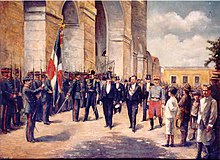
From 1902 on, short-lived governments were again the norm, with their power usurped by caudillos in parts of the country. Furthermore, the national government was bankrupt and, unable to pay its debts to European creditors, faced the threat of military intervention by France, Germany, and Italy.[94] United States President Theodore Roosevelt sought to prevent European intervention, largely to protect the routes to the future Panama Canal, as the canal was already under construction. He made a small military intervention to ward off European powers, to proclaim his famous Roosevelt Corollary to the Monroe Doctrine, and also to obtain his 1905 Dominican agreement for U.S. administration of Dominican customs, which was the chief source of income for the Dominican government. A 1906 agreement provided for the arrangement to last 50 years. The United States agreed to use part of the customs proceeds to reduce the immense foreign debt of the Dominican Republic and assumed responsibility for said debt.[40][94]

After six years in power, President Ramón Cáceres (who had himself assassinated Heureaux)[89] was assassinated in 1911. The result was several years of great political instability and civil war. U.S. mediation by the William Howard Taft and Woodrow Wilson administrations achieved only a short respite each time. A political deadlock in 1914 was broken after an ultimatum by Wilson telling the Dominicans to choose a president or see the U.S. impose one. A provisional president was chosen, and later the same year relatively free elections put former president (1899–1902) Juan Isidro Jimenes Pereyra back in power. To achieve a more broadly supported government, Jimenes named opposition individuals to his cabinet. But this brought no peace and, with his former Secretary of War Desiderio Arias maneuvering to depose him and despite a U.S. offer of military aid against Arias, Jimenes resigned on May 7, 1916.[95]
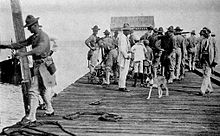
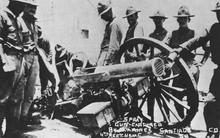

Wilson thus ordered the U.S. occupation of the Dominican Republic. U.S. Marines landed on May 16, 1916, and seized the capital and other ports, while General Arias fell back to his inland Santiago stronghold. In late June, the Marines began advancing from the north coast towards Santiago. On June 27, they encountered a strong defensive position on Las Trencheras Ridge. Covered by artillery, the Marines attacked and overran the position. The Dominicans fell back to a second defensive line but could not hold this either.[96] A peace delegation from Santiago surrendered the city on July 5, coinciding with General Arias' surrender to the Dominican governor. The U.S. then extended the occupation to the inland cities of Moca and La Vega.
The military government established by the U.S. on November 29, led by Vice Admiral Harry Shepard Knapp, was widely repudiated by the Dominicans, with caudillos in the mountainous eastern regions leading guerrilla campaigns against U.S. forces.[95] The Dominican insurgents, who typically operated in groups of less than 150 men, possessed mainly antiquated rifles, and more commonly, were armed only with pistols and shotguns.[97] The U.S. Marines were equipped with machine guns and modern artillery, resulting in a significant weaponry disparity that contributed to the defeat of the Dominican insurgents.[98] The U.S. Marines stationed in the Dominican Republic were Anglo-Americans. African-Americans were not allowed to join the Marines until 1942 due to segregation policies.
The occupation regime kept most Dominican laws and institutions and largely pacified the general population. The occupying government also revived the Dominican economy, reduced the nation's debt, built a road network that at last interconnected all regions of the country, and created a professional National Guard to replace the warring partisan units.[95] Additionally, with grass-roots support from local communities and assistance from both Dominican and US officials, the Dominican education system expanded significantly during US occupation. Between 1918 and 1920, more than three hundred schools were established nationwide.[99] The system of forced labour used by the Marines in Haiti was absent in the Dominican Republic.[100]

Opposition to the occupation continued, nevertheless, and after World War I it increased in the U.S. as well. There, President Warren G. Harding (1921–23), Wilson's successor, worked to put an end to the occupation, as he had promised to do during his campaign. The U.S. government's rule ended in October 1922, and elections were held in March 1924.[95] The victor was former president (1902–03) Horacio Vásquez, who had cooperated with the U.S. He was inaugurated on July 13, 1924, and the last U.S. forces left in September. In six years, the Marines were involved in at least 370 engagements, resulting in 950 "bandits" killed or wounded in action, while 144 Marines were killed and 50 were wounded.[101]
In 1930, General Rafael Trujillo, who was trained by the U.S. Marines during the occupation, seized power following a military revolt against the government of Vásquez. Desiderio Arias led a failed revolt against Trujillo and was killed near Mao in 1931.
Trujillo Era (1930–1961)
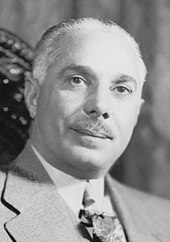
There was considerable economic growth during Rafael Trujillo's long and iron-fisted regime, although a great deal of the wealth was taken by the dictator and other regime elements. There was progress in healthcare, education, and transportation, with the building of hospitals, clinics, schools, roads, and harbors. Trujillo also carried out an important housing construction program and instituted a pension plan. He finally negotiated an undisputed border with Haiti in 1935, and achieved the end of the 50-year customs agreement in 1941, instead of 1956. He made the country debt-free in 1947.[40][102] This was accompanied by absolute repression and the copious use of murder, torture, and terrorist methods against the opposition. Several Dominicans were assassinated in New York after taking part in anti-Trujillo activities.[103] In October 1937, 40,000 Haitian men, women, and children were murdered by Dominican troops along the Haitian-Dominican border under the orders of Trujillo.[104]
During World War II, Trujillo symbolically sided with the Allies and declared war on Japan the day after the attack on Pearl Harbor and on Nazi Germany and Italy four days later. Soon after, German U-boats torpedoed and sank two Dominican merchant vessels that Trujillo had named after himself—the San Rafael off Jamaica and the Presidente Trujillo off Fort-de-France, Martinique. German U-boats also sank four Dominican-manned ships in the Caribbean. The country did not make a military contribution to the war, but Dominican sugar and other agricultural products supported the Allied war effort. Over a hundred Dominicans served in the American armed forces. After the war, the Dominican Republic began producing rifles, machine guns, and ammunition at San Cristóbal.[105]
Trujillo formed a Foreign Legion of 3,000 mercenaries to overthrow Fidel Castro in Cuba. Major William Morgan agreed to lead the attack for $1 million, but the invasion plan never materialized as Castro learned of the plot and instructed Morgan to go along with it and report back. The plan involved causing rebellion in the Sierra del Escambray and sabotaging the Cuban air force, followed by the Foreign Legion landing in Las Villas Province. Trujillo was tricked into believing that Morgan had captured Trinidad and that the airport was available to him, but remained reluctant to commit the Foreign Legion. On August 13, 1959, a C-47 transport flying from the Dominican Republic carrying military advisors and supplies landed at Trinidad airport. Castro seized the aircraft and the ten occupants and arrested some 4,000 suspects throughout Cuba.[106]
On November 25, 1960, Trujillo's henchmen killed three of the four Mirabal sisters, nicknamed Las Mariposas (The Butterflies). Along with their husbands, the sisters were conspiring to overthrow Trujillo in a violent revolt. The Mirabals had communist ideological leanings, as did their husbands. The sisters have received many honors posthumously and have many memorials in various cities in the Dominican Republic. Salcedo, their home province, changed its name to Provincia Hermanas Mirabal (Mirabal Sisters Province). The International Day for the Elimination of Violence against Women is observed on the anniversary of their deaths.

For a long time, the U.S. and the Dominican elite supported the Trujillo government. This support persisted despite the assassinations of political opposition, the massacre of Haitians, and Trujillo's plots against other countries. The U.S. believed Trujillo was the lesser of two or more evils.[107] The U.S. finally broke with Trujillo in 1960, after Trujillo's agents attempted to assassinate the Venezuelan president, Rómulo Betancourt, a fierce critic of Trujillo.[108][109] As the Venezuelan president was en route to preside over a military parade in Caracas, SIM agents detonated nearly 30 kg of explosives packed into two suitcases within a parked car nearby; Betancourt was injured, and Colonel Ramón Armas Perez, the chauffeur, and a bystander were killed.[110] Investigation revealed that the ammonium nitrate bomb had been assembled in Ciudad Trujillo (Santo Domingo), and that the operation was orchestrated by Johnny Abbes García, the chief of the secret police under Trujillo's regime. During Betancourt's earlier exile in Cuba, Trujillo's agents tried to inject poison into him on a Havana street in broad daylight.[110]
In June 1960, Trujillo legalized the Communist Party and unsuccessfully attempted to establish close political relations with the Soviet Bloc. Both the assassination attempt and the maneuver toward the Soviet Bloc provoked immediate condemnation throughout Latin America. After its representatives confirmed Trujillo's complicity in the nearly successful assassination attempt of Venezuela's president, the Organization of American States, for the first time in its history, decreed sanctions against a member state. The United States severed diplomatic relations with the Dominican Republic on August 26, 1960, and in January 1961 suspended the export of trucks, parts, crude oil, gasoline and other petroleum products. U.S. President Dwight D. Eisenhower also took advantage of OAS sanctions to cut drastically purchases of Dominican sugar, the country's major export. This action ultimately cost the Dominican Republic almost $22,000,000 in lost revenues at a time when its economy was in a rapid decline. Trujillo had become expendable.[111] Dissidents inside the Dominican Republic argued that assassination was the only certain way to remove Trujillo.[111][112]
According to Chester Bowles, the U.S. Undersecretary of State, internal Department of State discussions in 1961 on the topic were vigorous.[113] Richard N. Goodwin, Assistant Special Counsel to the President, who had direct contacts with the rebel alliance, argued for intervention against Trujillo.[113] Quoting Bowles directly: "The next morning I learned that in spite of the clear decision against having the dissident group request our assistance Dick Goodwin following the meeting sent a cable to CIA people in the Dominican Republic without checking with State or CIA; indeed, with the protest of the Department of State. The cable directed the CIA people in the Dominican Republic to get this request at any cost. When Allen Dulles found this out the next morning, he withdrew the order. We later discovered it had already been carried out."[113]
Post-Trujillo (1961–1996)

On May 30, 1961, Trujillo was shot and killed by Dominican dissidents when his blue 1957 Chevrolet Bel Air was ambushed on a road outside the Dominican capital.[108] Although the dissidents possessed Dominican-made San Cristóbal submachine guns, they symbolically used U.S.-made M-1 carbines supplied by the CIA to gun down Trujillo.[114] Out of the 14 Trujillo assassins, 12 were killed, some being fed to sharks.[114]
Ramfis Trujillo, the dictator's son, remained in de facto control of the government for the next 6 months, as commander of the armed forces. Trujillo's brothers, Hector Bienvenido and Jose Arismendi Trujillo, returned to the country and plotted against President Balaguer. On November 18, 1961, as a planned coup became more evident, U.S. Secretary of State Dean Rusk issued a warning that the US would not "remain idle" if the Trujillos attempted to "reassert dictatorial domination". Following this warning, and the arrival of a 14-vessel U.S. naval task force within sight of Santo Domingo, Ramfis and his uncles fled the country on November 19, with $200 million from the Dominican treasury. The OAS lifted its sanctions on January 4, 1962, as the Dominican Republic no longer posed a threat to regional security.
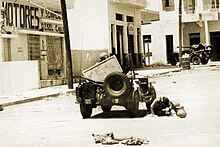
In February 1963, a democratically elected government under leftist Juan Bosch took office but it was overthrown in September. On April 24, 1965, after 19 months of military rule, a pro-Bosch revolt broke out in Santo Domingo.[115] The pro-Bosch forces (Constitutionalists) clashed with conservative military forces (Loyalists) on April 25. Despite tank assaults, strafing, and aerial bombardment by Loyalist forces, the Constitutionalists held their positions in the capital. By April 26, armed civilians outnumbered the original rebel military regulars. Radio Santo Domingo, now fully under rebel control, began to call for more violent actions and the killing of all police officers.[83]

On April 28, U.S. President Lyndon Johnson, concerned that communists might take over the revolt and create a "second Cuba", sent 24,000 troops into Santo Domingo in Operation Powerpack. "We don't propose to sit here in a rocking chair with our hands folded and let the Communist set up any government in the Western Hemisphere," Johnson said.[116] The forces were soon joined by comparatively small contingents from the Organization of American States (OAS).[117] Following U.S. intervention, psychological warfare became the primary weapon of the Constitutionalists, who numbered between 2,000 and 4,000. Dictator Trujillo had established an extensive and sophisticated telecommunications and radio broadcasting system that could reach every corner of the republic. Radio Santo Domingo, equipped with numerous alternative transmitter and antenna field sites, as well as relay stations, was nearly invulnerable. The Constitutionalist rebels adeptly utilized the radio to incite the population to revolt, and communicate with their own forces. Despite the robust electronic warfare capabilities of U.S. forces in the region, designed for military targets, they had limited effect on commercial transmitting systems. Therefore, the rebels were able to use this propaganda weapon until the main Radio Santo Domingo facility was physically put out of operation by Loyalist forces, who used the U.S. presence to deploy its forces and attack Constitutionalists.
Loyalist forces destroyed most Constitutionalist bases and captured the rebel radio station, effectively ending the war. A ceasefire was declared on May 21.[118] The US began withdrawing some troops by May 26. However, Col. Francisco Caamaño's untrained civilians attacked American positions on June 15. Despite the coordinated attack involving mortars, rocket launchers, and light tanks, the rebels lost a 56-square-block area to 82nd Airborne Division units which had received OAS permission to advance.[83] During this pitched battle, the armed civilians sustained 232 casualties and the US soldiers sustained 36 casualties.
Over 7,000 Dominicans were killed or wounded in the civil war, most prior to US intervention.[101] 48 Americans died and 189 were wounded in action.[101] US and OAS peacekeeping troops remained in the country for over a year and left after supervising elections in 1966 won by Joaquín Balaguer. He had been Trujillo's last puppet-president.[40][117] Balaguer remained in power as president for 12 years. His tenure was a period of repression of human rights and civil liberties, ostensibly to keep pro-Castro or pro-communist parties out of power; 11,000 persons were killed, tortured or forcibly disappeared.[119][120] His rule was criticized for a growing disparity between rich and poor. It was, however, praised for an ambitious infrastructure program, which included construction of large housing projects, sports complexes, theaters, museums, aqueducts, roads, highways, and the massive Columbus Lighthouse, completed in 1992 during a later tenure. During Balaguer's administration, the Dominican military forced Haitians to cut sugarcane on Dominican sugar plantations.[121]: 205

In 1978, Balaguer was succeeded to the presidency by opposition candidate Antonio Guzmán Fernández, of the Dominican Revolutionary Party (PRD). Hurricane David hit the Dominican Republic in August 1979, which left upwards of 2,000 people dead and 200,000 homeless. The hurricane caused over $1 billion in damage. Another PRD win in 1982 followed, under Salvador Jorge Blanco. Balaguer regained the presidency in 1986 and was re-elected in 1990 and 1994, in the latter defeating PRD candidate José Francisco Peña Gómez, a former mayor of Santo Domingo. The 1994 elections were flawed, bringing international pressure, to which Balaguer responded by scheduling another presidential contest in 1996. Balaguer was not a candidate. The PSRC candidate was his Vice President Jacinto Peynado Garrigosa.[122]
1996–present
In 1996, with the support of Joaquín Balaguer and the Social Christian Reform Party in a coalition called the Patriotic Front, Leonel Fernández achieved the first-ever win for the Dominican Liberation Party (PLD),[123] which Bosch had founded in 1973 after leaving the PRD (which he also had founded). Fernández oversaw a fast-growing economy: growth averaged 7.7% per year, unemployment fell, and there were stable exchange and inflation rates.[124] His administration supported the process of modernizing the judicial system, making transparent the creation of an independent Supreme Court of Justice. Efforts were also made to reform and modernize the other state bodies. In addition, relations with Cuba were reestablished[citation needed] and the Free Trade Agreement with Central America was signed, which was the genesis for the signing of DR-CAFTA.

In 2000, the PRD's Hipólito Mejía won the election. This was a time of economic troubles.[124] Under Mejía, the Dominican Republic participated in the US-led coalition, as part of the Multinational Plus Ultra Brigade, during the 2003 invasion of Iraq, suffering no casualties. In 2004, the country withdrew its approximately 300 soldiers from Iraq. The Dominican Republic has also contributed troops to the United Nations Interim Force in Lebanon (UNIFIL), and the United Nations Multidimensional Integrated Stabilization Mission in Mali (MINUSMA).
In 2008, Fernández was elected for a third term.[125] Fernández and the PLD are credited with initiatives that have moved the country forward technologically, on the other hand, his administrations have been accused of corruption.[124]
Danilo Medina of the PLD was elected president in 2012 and re-elected in 2016. On the other hand, a significant increase in crime, government corruption and a weak justice system threaten to overshadow their administrative period.[126][127]
He was succeeded by the opposition candidate Luis Abinader in the 2020 election (weeks after protests erupted in the country against Medina's government), marking the end to 16 years in power of the centre-left Dominican Liberation Party (PLD).[128][129]
Geography

The Dominican Republic comprises the eastern five-eighths of Hispaniola, the second-largest island in the Greater Antilles, with the Atlantic Ocean to the north and the Caribbean Sea to the south. It shares the island roughly at a 2:1 ratio with Haiti, the north-to-south (though somewhat irregular) border between the two countries being 376 km (234 mi).[4] To the north and north-west lie The Bahamas and the Turks and Caicos Islands, and to the east, across the Mona Passage, the US Commonwealth of Puerto Rico. The country's area is reported variously as 48,442 km2 (18,704 sq mi) (by the embassy in the United States)[14] and 48,670 km2 (18,792 sq mi),[4] making it the second largest country in the Antilles, after Cuba. The Dominican Republic's capital and largest city Santo Domingo is on the southern coast.[4]
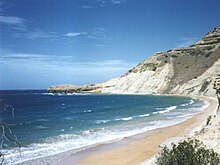
The Dominican Republic has four important mountain ranges. The most northerly is the Cordillera Septentrional ("Northern Mountain Range"), which extends from the northwestern coastal town of Monte Cristi, near the Haitian border, to the Samaná Peninsula in the east, running parallel to the Atlantic coast. The highest range in the Dominican Republic – indeed, in the whole of the West Indies – is the Cordillera Central ("Central Mountain Range"). It gradually bends southwards and finishes near the town of Azua, on the Caribbean coast. In the Cordillera Central are the four highest peaks in the Caribbean: Pico Duarte (3,098 metres or 10,164 feet above sea level),[4] La Pelona (3,094 metres or 10,151 feet), La Rucilla (3,049 metres or 10,003 feet), and Pico Yaque (2,760 metres or 9,055 feet). In the southwest corner of the country, south of the Cordillera Central, there are two other ranges: the more northerly of the two is the Sierra de Neiba, while in the south the Sierra de Bahoruco is a continuation of the Massif de la Selle in Haiti. There are other, minor mountain ranges, such as the Cordillera Oriental ("Eastern Mountain Range"), Sierra Martín García, Sierra de Yamasá, and Sierra de Samaná.
Between the Central and Northern mountain ranges lies the rich and fertile Cibao valley. This major valley is home to the cities of Santiago and La Vega and most of the farming areas of the nation. Rather less productive are the semi-arid San Juan Valley, south of the Central Cordillera, and the Neiba Valley, tucked between the Sierra de Neiba and the Sierra de Bahoruco. Much of the land around the Enriquillo Basin is below sea level, with a hot, arid, desert-like environment. There are other smaller valleys in the mountains, such as the Constanza, Jarabacoa, Villa Altagracia, and Bonao valleys.

The Llano Costero del Caribe ("Caribbean Coastal Plain") is the largest of the plains in the Dominican Republic. Stretching north and east of Santo Domingo, it contains many sugar plantations in the savannahs that are common there. West of Santo Domingo its width is reduced to 10 kilometres (6.2 mi) as it hugs the coast, finishing at the mouth of the Ocoa River. Another large plain is the Plena de Azua ("Azua Plain"), a very arid region in Azua Province. A few other small coastal plains are on the northern coast and in the Pedernales Peninsula.
Four major rivers drain the numerous mountains of the Dominican Republic. The Yaque del Norte is the longest and most important Dominican river. It carries excess water down from the Cibao Valley and empties into Monte Cristi Bay, in the northwest. Likewise, the Yuna River serves the Vega Real and empties into Samaná Bay, in the northeast. Drainage of the San Juan Valley is provided by the San Juan River, tributary of the Yaque del Sur, which empties into the Caribbean, in the south. The Artibonito is the longest river of Hispaniola and flows westward into Haiti.
Zdroj:https://en.wikipedia.org?pojem=Administrative_divisions_of_the_Dominican_Republic
Text je dostupný za podmienok Creative Commons Attribution/Share-Alike License 3.0 Unported; prípadne za ďalších podmienok. Podrobnejšie informácie nájdete na stránke Podmienky použitia.
Antropológia
Aplikované vedy
Bibliometria
Dejiny vedy
Encyklopédie
Filozofia vedy
Forenzné vedy
Humanitné vedy
Knižničná veda
Kryogenika
Kryptológia
Kulturológia
Literárna veda
Medzidisciplinárne oblasti
Metódy kvantitatívnej analýzy
Metavedy
Metodika
Text je dostupný za podmienok Creative
Commons Attribution/Share-Alike License 3.0 Unported; prípadne za ďalších
podmienok.
Podrobnejšie informácie nájdete na stránke Podmienky
použitia.
www.astronomia.sk | www.biologia.sk | www.botanika.sk | www.dejiny.sk | www.economy.sk | www.elektrotechnika.sk | www.estetika.sk | www.farmakologia.sk | www.filozofia.sk | Fyzika | www.futurologia.sk | www.genetika.sk | www.chemia.sk | www.lingvistika.sk | www.politologia.sk | www.psychologia.sk | www.sexuologia.sk | www.sociologia.sk | www.veda.sk I www.zoologia.sk




